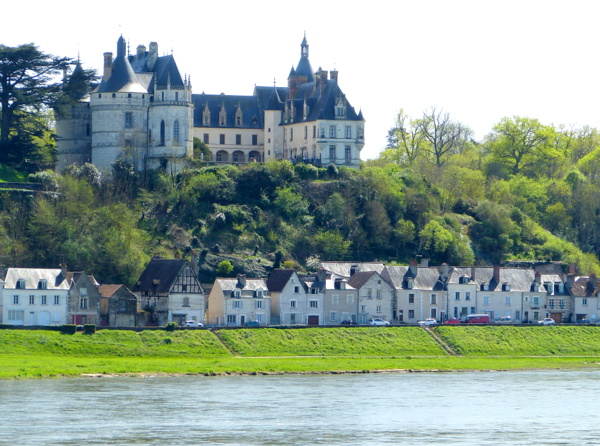
Chateau de Chaumont-sur-Loire overlooks the Loire and the village of Chaumont-sur-Loire in central France. (All Photos: Yvonne Michie Horn)
FRANCE Chaumont-sur-Loire – During my six week’s stay in the Loire Valley, headquartered in the city of Blois with the goal of improving my French language skills, I often passed the nearby Chateau de Chaumont-sur-Loire’s fairy tale of turrets as I drove the riverside road on explorations into the countryside. The Chateau, high on a bluff, gracefully proclaimed its supremacy on the village of Chaumont-sur-Loire below while admiring its reflection in the waters of the Loire.
Pretty and smallish among the Loire’s profusion of over-the-top-architecturally grandiose edifices, there was nothing about the chateau that enticed me to cross the bridge and take a look until I was nearing the end of my stay. Once again, Chateau Chaumont-sur-Loire would be throwing open the gates in April for its annual Festival International des Jardins.
Festival in its 24th year honored collectors….
For the 2015 festival, more than 300 landscape architects and designers, located worldwide, threw their trowels in the ring in the hope that their proposal would be one of 24 selected for installation in an assigned 700-square-foot plot.
From its beginning in 1992, the festival’s stated reason for being was to breathe new life and energy into garden artistry. Each year presented a different theme. This year’s theme: Collector’s Gardens.
To collect is to fall in love with a certain genre and gather examples of them. Collectors seek out what is precious to them – rare, unique, diverse, original – amassing their treasures together. So it can be within the world of plants.
The Garden of 101 Pelargonium’s paid tribute to the diversity of flowers, fragrances, leaf shapes, textures and colors within the pelargonium family. Each in its own labeled barrel, I wandered past Bird Dancer, Purple gypsy, Meadowside Midnight and 98 others, sinking my nose into the aptly named Cola Bottles and Chocolate Peppermint.
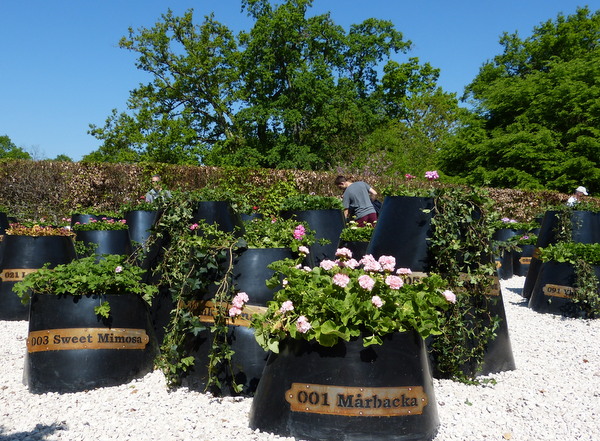
Pelargorniums 101 different varieties, showcase the diversity of bloom, leaves, and fragrance within the Palargornium family.
Dozens of sieves, the botanist ‘s essential tool for sorting seeds, hung from wires and were mounted on posts in the seed collectors garden. The sieves displayed seeds’ visual diversity, some resembling large, winged insects, others surprising in their color or decorative markings, all containing the potential to become a living plant.
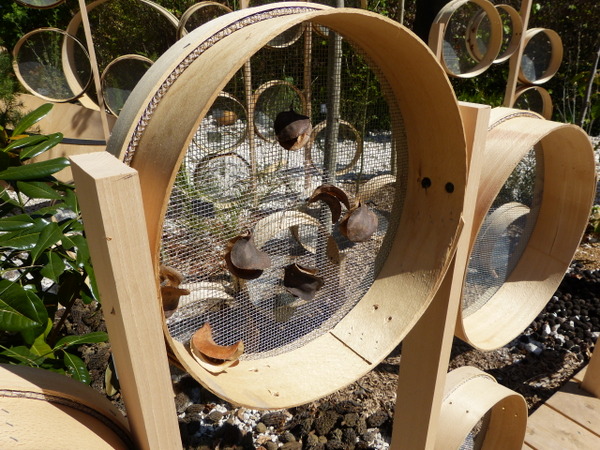
Botanist sieves, hung on wires and mounted on posts displayed seeds visual diversity.
The A Table! garden celebrated the sharing of a meal. A long table was filled with a collection of extraordinary fruit and vegetable varieties, most belonging to very old species virtually unheard of today. What I first took to be Chinese lanterns decorating the garden, turned out to be carnivorous plants enjoying their own a table experience.
Noah’s Ark was in the process of loading, this time not with animals boarding two by two but with the finest plants chosen from his collection. Inside, the ark was transformed into a jewelry box of green treasures arranged in wooden enclosures to protect them from the coming storm.

Visiting School children, nose deep in the A Table! garden’s table-level assortment of plants.
On it went, with each garden presenting a surprising take on collections.
Permanent gardens …
So fascinating are the festival gardens that one might tempted to skip the six permanent installations by international designers in the Prés du Goualoup. Fortunately, I’d read my map wrong and found myself there at the beginning of my visit to the chateau.
Located on two-and –a half acres, large gardens are designed to be developed over time. The theme remains constant – gardens inspired by the great gardens of civilization. Instead of reproducing gardens typical of a specific area of the world, installations explore a contemporary take on the traditional.
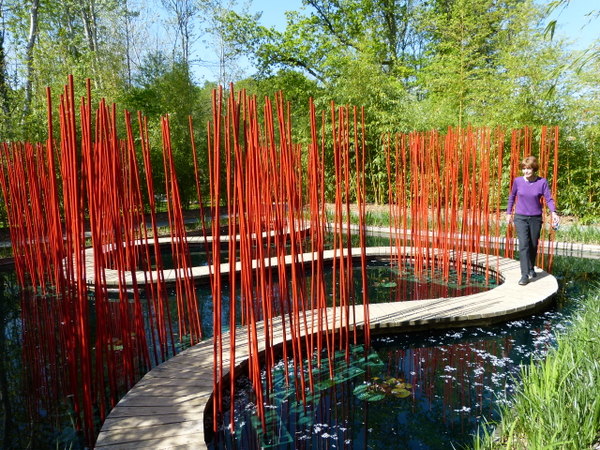
Serpentine reflections invite a boardwalk stroll through the Japanese garden in the permanent collections, installations that explore a take on traditional gardens of the world.
For example, traditional Korean gardens define themselves as “a large vessel for a mystical empty space.” In the Jardin Coréen, the concept is turned on its head. Dozens of not-large-at-all , identical ceramic vessels are gathered together and placed around structured ponds bordered with flowering shrubs.
Chateau embraced by extensive grounds ….
I was surprised at the extensiveness of the chateau’s surrounding grounds, making me regret that I’d not crossed the bridge earlier in my stay.Wooden walkways and stairs took me deep into a canyon lush with greenery and filled with bird song where I would have liked to linger longer.
I walked quickly through the Parc Historique, 50 acres designed in the “English style “ of gently rolling terrain designed by Henri Duchene one of the great French landscape architects of the late 19th century, enhanced today by large pieces of contemporary sculpture placed throughout the park.

Large, contemporary sculptures are placed here and there in throughout the 50-acre, Egnlish-style Parc Historique.
As for the chateau itself, alas, its interior failed to match the expectations of its fairy tale exterior. I hurried through its rooms, my day at Chaumont-sur-Loire was going fast and I wanted to return to the festival for a second look at several of the gardens.
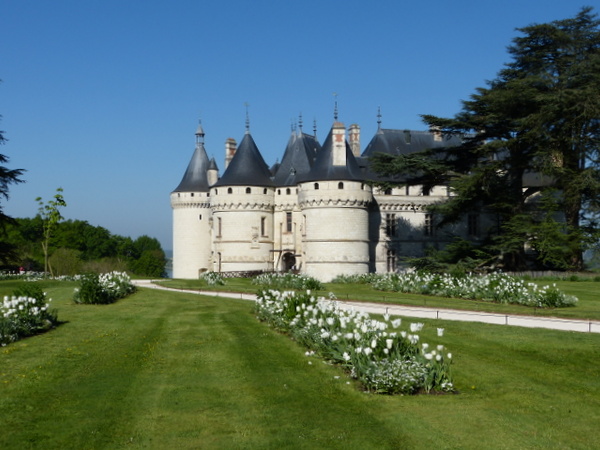
Gardened areas on the theme of white, with white tulips predominating, enhance Chateau Chaumont-sur-Loire’s fairy-tale exterior.
If you go ….
The Festival International des Jardins is open from late April until the first part of November. An entry fee, approximately $15, is charged for the festival only or near $20 to visit the entirety of the domaine. Chaumont- sur-Loire is locate about 12 kilometers south of the city of Blois, in the Loir-et-Cher region of central France.
This is the last in a series of four Loire Valley gardens. You may find the other three in “Locations” and clicking on France. The first article describes Chédigny, a tiny village designated in its entirety a Jardin Remarquable. The second features Chateau du Clos Lucé tells of a garden with deep roots to Leonardo da Vinci. The third relates a walk with the owner of Jardin du Plessis, located near the small village of Sasniéres, part of a larger property in family ownership since the 15th century.
